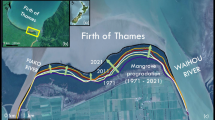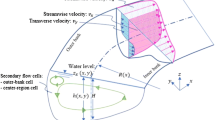Abstract
Lateral gravity currents can play a critical role in the exchange of materials between terrestrial and marine ecosystems. The three-dimensional flow structure and mixing process of the gravity current, discharged from a lateral rectangular lock into an ambient fluid, are investigated by solving Unsteady Reynolds-averaged Navier-Stokes equations with the RNG k-ε turbulence model. The accuracy and consistency of the developed model are checked using the experimental data of the lock-exchange in the straight channel, lateral flow in the open channel and mass exchange in the cavity. The agreement between measured and simulated flow and concentration fields is reasonable. The lateral gravity current without the main channel discharge spreads radially out and is arrested by the other bank of the main channel. Before reaching the other bank, the lateral gravity current evolves into the acceleration, slumping, and inertial phases. The gravity current remains in the slumping phase at a straight channel without the tributary. The mixing layer is more diluted at the lateral gravity current. As the main channel discharge increases, the symmetry plume is broken, and the dense fluid propagation is limited toward the confluence upstream. The time-evolution of discharged spatially averaged density decreases due to increasing the main channel discharge. The mixing process assessment indicated that the entrainmant of the lateral gravity current without the main channel discharge is more intense compared with the cases having discharge. The decreasing lateral Froude number associated with increasing main channel discharge leads to a decrease in the entrainment.



























Similar content being viewed by others
References
Allen J (1985) Principles of physical sedimentology. George Allen and Unwin Ltd
Simpson J (1997) Gravity currents. Cambridge University Press, Cambridge
Elias RN, Paraizo PL, Coutinho AL (2008) Stabilized edge based finite element computation of gravity currents in lock-exchange configurations. Int J Numer Meth Fluids 57(9):1137–1152
Keulegan GH (1950) Interfacial instability and mixing in stratified flows. US Department of Commerce, National Bureau of Standards
Simpson JE, Britter RE (1979) The dynamics of the head of a gravity current advancing over a horizontal surface. J Fluid Mech 94(3):477–495
Huppert HE, Simpson JE (1980) The slumping of gravity currents. J Fluid Mech 99(4):785–799
Garcia M, Parker G (1993) Experiments on the entrainment of sediment into suspension by a dense bottom current. J Geophys Res: Oceans 98(C3):4793–4807
García MH, Parsons JD (1996) Mixing at the front of gravity currents. Dyn Atmos Oceans 24(1–4):197–205
Hacker J, Linden PF, Dalziel SB (1996) Mixing in lock-release gravity currents. Dyn Atmos Oceans 24(1–4):183–195
Hallworth MA, Huppert HE, Phillips JC, Sparks RS (1996) Entrainment into two-dimensional and axisymmetric turbulent gravity currents. J Fluid Mech 308:289–311
Parsons JD, Garcıa MH (1998) Similarity of gravity current fronts. Phys Fluids 10(12):3209–3213
Kneller BC, Bennett SJ, McCaffrey WD (1999) Velocity structure, turbulence and fluid stresses in experimental gravity currents. J Geophys Res: Oceans 104(C3):5381–5391
Peakall J, Amos KJ, Keevil GM, Bradbury PW, Gupta S (2007) Flow processes and sedimentation in submarine channel bends. Mar Pet Geol 24(6–9):470–486
Shin JO, Dalziel SB, Linden PF (2004) Gravity currents produced by lock exchange. J Fluid Mech 521:1–34
Sequeiros OE, Spinewine B, Beaubouef RT, Sun T, Garcia MH, Parker G (2010) Bedload transport and bed resistance associated with density and turbidity currents. Sedimentology 57(6):1463–1490
Islam MA, Imran J (2008) Experimental modeling of gravity underflow in a sinuous submerged channel. J Geophys Res: Oceans 113(C7):58
Ezz H, Cantelli A, Imran J (2013) Experimental modeling of depositional turbidity currents in a sinuous submarine channel. Sed Geol 290:175–187
Paik J, Eghbalzadeh A, Sotiropoulos F (2009) Three-Dimensional unsteady RANS modeling of discontinuous gravity currents in rectangular domains. J Hydraul Eng 135(6):505–521
Huang H, Imran J, Pirmez C (2008) Numerical study of turbidity currents with sudden-release and sustained-inflow mechanisms. J Hydraul Eng 134(9):1199–1209
Gerber G, Diedericks G, Basson GR (2010) Particle image velocimetry measurements and numerical modeling of a saline density current. J Hydraul Eng 137(3):333–342
Adduce C, Sciortino G, Proietti S (2011) Gravity currents produced by lock exchanges: experiments and simulations with a two-layer shallow-water model with entrainment. J Hydraul Eng 138(2):111–121
Härtel C, Meiburg E, Necker F (2000) Analysis and direct numerical simulation of the flow at a gravity-current head. part 1. flow topology and front speed for slip and no-slip boundaries. J Fluid Mech 418:189–212
Necker F, Härtel C, Kleiser L, Meiburg E (2002) High-resolution simulations of particle-driven gravity currents. Int J Multiph Flow 28(2):279–300
Necker F, Härtel C, Kleiser L, Meiburg E (2005) Mixing and dissipation in particle-driven gravity currents. J Fluid Mech 545:339–372
Birman VK, Martin JE, Meiburg E (2005) The non-Boussinesq lock-exchange problem. part 2 high-resolution simulations. J Fluid Mech 537:125–144
Ooi SK (2006) High resolution numerical simulations of lock-exchange gravity-driven flows. University of Iowa
Ooi SK, Constantinescu G, Weber LJ (2006) Numerical simulation of lock-exchange gravity driven flows. IIHR Technical Rep 450
Ooi SK, Constantinescu G, Weber LJ (2007) 2D large-eddy simulation of lock-exchange gravity current flows at high Grashof numbers. J Hydraul Eng 133(9):1037–1047
An S, Julien PY, Venayagamoorthy SK (2012) Numerical simulation of particle-driven gravity currents. Environ Fluid Mech 12(6):495–513
Tokyay TE, García MH (2014) Effect of initial excess density and discharge on constant flux gravity currents propagating on a slope. Environ Fluid Mech 14(2):409–429
Jackson PR, García CM, Oberg KA, Johnson KK, García MH (2008) Density currents in the Chicago River: characterization, effects on water quality, and potential sources. Sci Total Environ 401(1–3):130–143
Ribeiro CH, Waniek JJ, Sharples J (2004) Observations of the spring–neap modulation of the gravitational circulation in a partially mixed estuary. Ocean Dyn 54(3–4):299–306
Lyubimova T, Lepikhin A, Konovalov V, Parshakova Y, Tiunov A (2014) Formation of the density currents in the zone of confluence of two rivers. J Hydrol 508:328–342
Guide R (1989) Best Estimate Calculations of Emergency Core Cooling System Performance. US Nuclear Regulatory Commission
Buschman FA, Van Der Vegt M, Hoitink AJ, Hoekstra P (2013) Water and suspended sediment division at a stratified tidal junction. J Geophys Res: Oceans 118(3):1459–1472
Imran J, Kassem A, Khan SM (2004) Three-dimensional modeling of density current i flow in straight confined and unconfined channels. J Hydraul Res 42(6):578–90
Warner J, Schoellhamer D, Burau J, Schladow G (2002) Effects of tidal current phase at the junction of two straits. Cont Shelf Res 22(11–13):1629–1642
Ismail H (2017) Confluence of density currents produced by lock -exchange. University of South Carolina
Bombardelli FA, García MH (2001) Simulation of density currents in urban environments. Application to the Chicago River, Illinois. In: Proceedings, 3rd. International Symposium Environmental Hydraulics
García CM, Manríquez C, Oberg K, García MH (2005) Density currents in the Chicago River, Illinois. River, Coastal and Estuarine Morphodynamics: RCEM 191–202
García CM, Oberg K, García MH (2007) ADCP measurements of gravity currents in the Chicago River Illinois. J Hydraul Eng 133(12):1356–1366
Ismail H, Viparelli E, Imran J (2016) Confluence of density currents over an erodible bed. J Geophys Res Earth Surf 121(7):1251–1272
Ramón CL, Prats J, Rueda FJ (2016) The influence of flow inertia, buoyancy, wind, and flow unsteadiness on mixing at the asymmetrical confluence of two large rivers. J Hydrol 539:11–26
Yakhot VS, Orszag SA, Thangam S, Gatski TB, Speziale CG (1992) Development of turbulence models for shear flows by a double expansion technique. Phys Fluids A 4(7):1510–1520
Javan M, Mahmodinia S, Hasani H (2017) Development and validation of a Lagrangian method for 3D turbulent flows with curvilinear free-surface. Environ Fluid Mech 17(6):1153–1170
Patankar SV (1980) Numerical heat transfer and fluid flow. Hemisphere, New York
Chen HC, Patel VC (1988) Near-wall turbulence models for complex flows including separation. AIAA J 26(6):641–648
Mahmodinia S, Javan M (2018) Three-dimensional features in non-equal and opposing flow junctions. Acta Mech 229(11):4357–4374
Javan M, Eghbalzadeh A (2013) 2D numerical simulation of submerged hydraulic jumps. Appl Math Model 37(10–11):6661–6669
Mahmodinia S, Javan M (2020) Mixing process in opposing flow junction with different angles and junction radii. Acta Geophys 68:795–809
Mahmodinia S, Javan M (2021) Continuous and discontinuous gravity currents in open-channel embayments. Environ Sci Pollut Res 5:1–19
Frizzell CS, Khan AA, Werth DE (2008) Numerical simulation of equal and opposing subcritical flow junctions. J Hydraul Eng 134(2):267–273
Mignot E, Cai W, Launay G, Riviere N, Escauriaza C (2016) Coherent turbulent structures at the mixing-interface of a square open-channel lateral cavity. Phys Fluids 28(4):045104
Mignot E, Cai W, Polanco JI, Escauriaza C, Riviere N (2017) Measurement of mass exchange processes and coefficients in a simplified open-channel lateral cavity connected to a main stream. Environ Fluid Mech 17(3):429–448
Weber LJ, Schumate ED, Mawer N (2001) Experiments on flow at a 90 open-channel junction. J Hydraul Eng 127(5):340–350
Mizumura K, Yamasaka M (2002) Flow in open-channel embayments. J Hydraul Eng 128(12):1098–1101
Jackson TR, Apte SV, Haggerty R (2014) Effect of multiple lateral cavities on stream solute transport under non-Fickian conditions and at the Fickian asymptote. J Hydrol 519:1707–1722
Wang P (2017) A high-order spatiotemporal precision-matching Taylor–Li scheme for time-dependent problems. Adv Atmos Sci 34(12):1461–1471
Hussain F, Jeong J (1995) On the identification of a vortex. J Fluid Mech 285:69–94
Cantero MI, Balachandar S, Garcia MH (2007) High-resolution simulations of cylindrical density currents. J Fluid Mech 590:437–469
Ooi SK, Constantinescu G, Weber LJ (2009) Numerical simulations of lock-exchange compositional gravity current. J Fluid Mech 635:361–388
Geyer WR, Hill P, Milligan T, Traykovski P (2000) The structure of the Eel River plume during floods. Cont Shelf Res 20(16):2067–2093
Godin G (1991) Frictional effects in river tides. Tidal Hydrodyn 379:402
Kukulka T, Jay DA (2003) Impacts of Columbia River discharge on salmonid habitat: 1. a nonstationary fluvial tide model. J Geophys Res: Oceans 108(C9):45
Jia Y, Whitney MM (2019) Summertime connecticut river water pathways and wind impacts. J Geophys Res: Oceans 124(3):1897–1914
Kenworthy ST, Rhoads BL (1995) Hydrologic control of spatial patterns of suspended sediment concentration at a stream confluence. J Hydrol 168(1–4):251–263
Ottolenghi L, Adduce C, Inghilesi R, Armenio V, Roman F (2016) Entrainment and mixing in unsteady gravity currents. J Hydraul Res 54(5):541–557
Hunt JCR, Rottman JW, Britter RE (1983) Some physical processes involved in the dispersion of dense gases. In Proc. IUTAM Symp. on Atmospheric Dispersion of Heavy Gases and Small Particles: 361–395
Balasubramanian S, Zhong Q (2018) Entrainment and mixing in lock-exchange gravity currents using simultaneous velocity-density measurements. Phys Fluids 30(5):056601
Jacobson MR, Testik FY (2014) Turbulent entrainment into fluid mud gravity currents. Environ Fluid Mech 14(2):541–563
Cenedese C, Adduce C (2008) Mixing in a density-driven current flowing down a slope in a rotating fluid. J Fluid Mech 604:369–388
Cenedese C, Adduce C (2010) A new parameterization for entrainment in overflows. J Phys Oceanogr 40(8):910
Nogueira HIS, Adduce C, Alves E, Franca MJ (2014) Dynamics of the head of gravity currents. Environ Fluid Mech 14:519–540
Ellison TH, Turner JS (1959) Turbulent entrainment in stratified flows. J Fluid Mech 6(3):423–448
Johnson CG, Hogg AJ (2013) Entraining gravity currents. J Fluid Mech 731:477–508
Author information
Authors and Affiliations
Corresponding author
Additional information
Publisher's Note
Springer Nature remains neutral with regard to jurisdictional claims in published maps and institutional affiliations.
Rights and permissions
About this article
Cite this article
Mahmodinia, S., Javan, M. Vortical structures, entrainment and mixing process in the lateral discharge of the gravity current. Environ Fluid Mech 21, 1035–1067 (2021). https://doi.org/10.1007/s10652-021-09808-3
Received:
Accepted:
Published:
Issue Date:
DOI: https://doi.org/10.1007/s10652-021-09808-3




